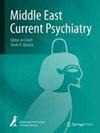Generalized anxiety disorder and sleep quality during COVID-19 lockdown in Egypt: a web-based cross-sectional survey
IF 1.6
Q3 PSYCHIATRY
引用次数: 0
Abstract
Abstract Background Coronavirus disease (COVID-19) was identified in China in December 2019. During any major epidemic, psychosocial disturbance occurs, which can surpass people’s capacity to handle the condition. Objective The study aimed to estimate the prevalence of anxiety disorder and to assess sleep quality among Egyptian adults during COVID-19 lockdown. Methods The study was cross-sectional study through an anonymous web-based survey. Results Majority of participants were females (80.3%), highly educated (96.8%), and with mean age of 32.9 ± 8.7 years. Nearly two-thirds were healthcare workers (65.5%). The overall prevalence of anxiety (generalized anxiety disorder score more than 9) was 42.5%. Nearly three-fourth (73.5%) of participants reported poor sleep quality (Pittsburgh Sleep Quality Index score more than 5). In the multivariate logistic regression models, being female (adjusted odds ratio = 1.75, 95% confidence interval: 1.13–2.7 for anxiety and adjusted odds ratio = 2.217, 95% confidence interval: 1.461–3.364 for poor sleep quality), younger than 35 years (adjusted odds ratio = 0.537, 95% confidence interval: 0.376–0.767 for anxiety and adjusted odds ratio = 0.578, 95% confidence interval: 0.397–0.841 for poor sleep quality), and focusing more time on COVID-19 news (adjusted odds ratio = 1.937, 95% confidence interval: 1.601–2.343 for anxiety and adjusted odds ratio = 1.494, 95% confidence interval: 1.219–1.83 for poor sleep quality) were significant predictors of anxiety and poor sleep quality. Conclusion There was an increase in both anxiety and sleep disorders during COVID-19 pandemic. Young women spending more time on COVID-19 were at higher risk of developing anxiety and poor sleep quality.埃及COVID-19封锁期间的广泛性焦虑症和睡眠质量:一项基于网络的横断面调查
背景2019年12月,中国首次发现新型冠状病毒病(COVID-19)。在任何重大流行病期间,都会发生社会心理障碍,这可能超出人们处理这种情况的能力。该研究旨在估计新冠肺炎封锁期间埃及成年人焦虑障碍的患病率,并评估睡眠质量。方法采用网络匿名调查的横断面研究方法。结果患者以女性(80.3%)为主,高学历(96.8%),平均年龄(32.9±8.7)岁。近三分之二是卫生保健工作者(65.5%)。焦虑的总体患病率(广泛性焦虑障碍评分大于9)为42.5%。近四分之三(73.5%)的参与者报告睡眠质量差(匹兹堡睡眠质量指数得分超过5分)。在多变量logistic回归模型中,女性(焦虑调整优势比= 1.75,95%置信区间为1.13-2.7,睡眠质量差调整优势比= 2.217,95%置信区间为1.461-3.364),年龄小于35岁(调整优势比= 0.537,95%置信区间为:焦虑为0.376 ~ 0.767,调整优势比= 0.578,95%可信区间为0.397 ~ 0.841,睡眠质量差),关注COVID-19新闻的时间较多(调整优势比= 1.937,95%可信区间为1.601 ~ 2.343,调整优势比= 1.494,95%可信区间为1.219 ~ 1.83)是焦虑和睡眠质量差的显著预测因子。结论新冠肺炎大流行期间,焦虑和睡眠障碍均有所增加。在COVID-19上花费更多时间的年轻女性患焦虑和睡眠质量差的风险更高。
本文章由计算机程序翻译,如有差异,请以英文原文为准。
求助全文
约1分钟内获得全文
求助全文
来源期刊

Middle East Current Psychiatry
Medicine-Psychiatry and Mental Health
CiteScore
3.00
自引率
0.00%
发文量
89
审稿时长
9 weeks
 求助内容:
求助内容: 应助结果提醒方式:
应助结果提醒方式:


